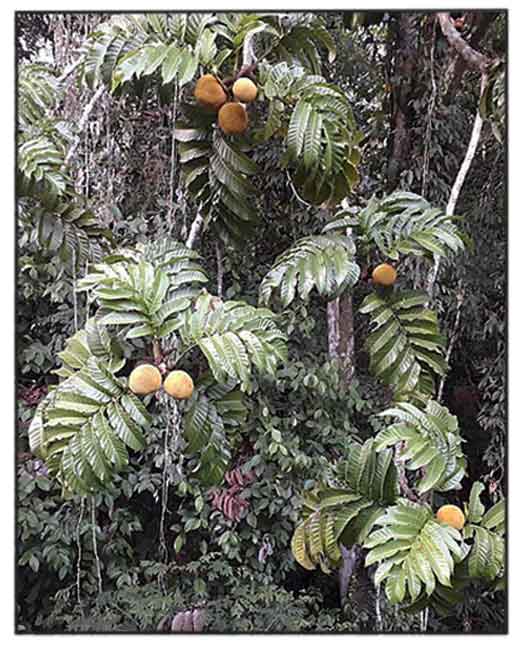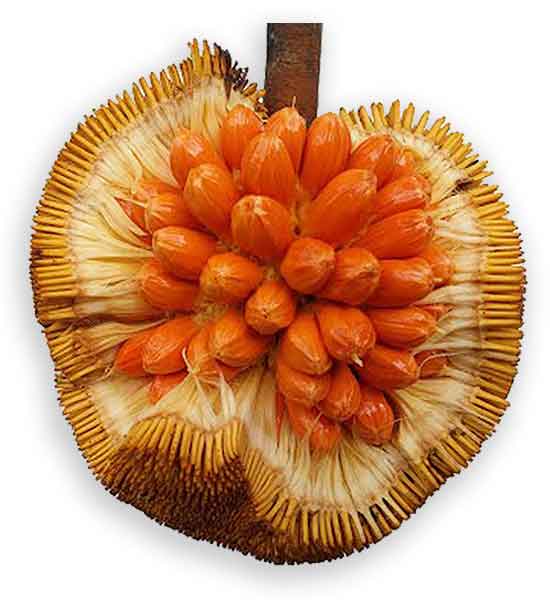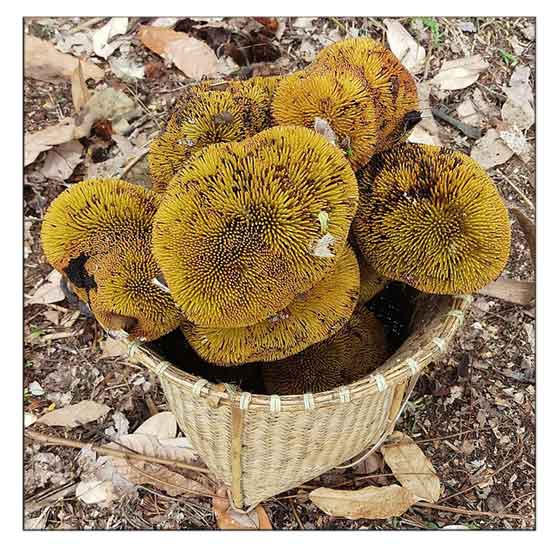 Gen info Gen info
- Artocarpus is a genus of about 60 trees and shrubs of Southeast Asian and Pacific origin, belonging to the mulberry family, Moraceae. Two cultivated species are A. altilis (breadfruit) and A. heterophyllus (jackfruit).
- It is considered a relative of marang, langka, rimas, and kamansi.
- Etymology: The genus Artocarpus is derived from Greek words artos "bread" and karpos "fruit". Specific epithet anisophyllus derives from Latin meaning "with unequal leaves".
- Fossils of Artocarpus have been reported as early as the late Cretaceopis.
(2)
-
Artocarpus anisophyllus is a tropical tree in the Moraceae family.
Botany
• Tree up to 45 m tall, 90 cm diameter; buttresses spreading, up to 2.5 m tall. Bark dark gray, smooth to dippled; inner bark yellowish brown. Twigs stout, c. 1 cm thick, smooth or irregularly ridged, set with ring-like stipular scars. Stipules amplexicaul, 4-17 cm long, appressed pubescent. Leaves spirally arranged, compound-imparipinnate, rachis up to 90 cm long. Leaflets oblong, ovate or lanceolate, 3.5-40 x 2-13 cm, subopposite, unequal in size, smaller ones alternating with larger ones, terminal leaflets almost always bifid; midrib raised above; lateral veins 7-20 pairs, sunken above, raised below; venation scalariform, faint to distinct below, faint above. Inflorescences axillary, males and females usually paired; bracts slenderly stalked, apical parts funnel-shaped; peduncle 5-6.5 cm long. Male heads ellipsoid-oblong, 3-7.5 x 1.5-2 cm; perianth tubular, c. 1.8 mm long, shortly bilobed, minutely hairy; stamens 2-2.5 mm long, filament slender, cylindrical, anthers subglobose, c. 0.2 mm long. Syncarps subglobose, up to 11 x 8 cm, covered with cylindrical, rigid, minutely punctate, obtuse processes (perianth-apices) 6- 8 x 1-1.5 mm; pulp (fleshy perianth) orange; peduncle 6-13 cm. Seeds ellipsoid, c. 1.7 x 1 cm. (Tree Flora of Sabah and Sarawak) (3)
 Distribution Distribution
- Native to the Philippines.
- Also native to Borneo, Malaya, Sumatera, Thailand. (1)
- In undisturbed to slightly disturbed mixed dipterocarp forests up to 700 m altitude. On alluvival sites near rivers and streams; also on hillsides and ridges, on sandy to clay soils, and limestone. (3)
- IUCN classified as
"Vulnerable".
Constituents
- Study of leaves and heartwoods of A. anisophyllus isolated two new prenylated flavonoids, 4′,5-dihydroxy-6,7-(2,2-dimethylpyrano)-2′-methoxy-8-γ,γ-dimethylallylflavone (1), and 3′-hydroxycycloartocarpin (2) along with six known flavonoids, 5,7-dihydroxy-4′-methoxy-8-prenylflavanone (3), isobavachalcone (4), pyranocycloartobiloxanthone A (5), artocarpin (6), chaplashin (7) and cycloartocarpin (8). (see study below) (4)
- Phytochemical screening of crude extract of stem bark yielded alkaloids, triterpenoids, phenolics, and flavonoids. (see study below) (6)
- Study of leaves and heartwoods isolated seven flavonoids, fully characterized spectroscopically as artocarpin (1), isobavachalcone (2), pyranocycloartobiloxanthone A (3), 5,7-dihydroxy-4'-methoxy-6-prenylflavanone (4), 5-hydroxy-7,8-(2,2-dimethylchromano)-4'-methoxy-flavanone (5) 4',5-dihydroxy-6,7-(2,2-dimethylpyrano)-2'-methoxy-8-γ,γ-dimethylallylflavone (6) and 2',4'-dihydroxy-3,4-(2",2"-dimethylchromeno)-3'-prenyldihydrochalcone (7). (see study below) (9)
- Nutritional contents of fruit per 100 g: Energy 431 kJ (103 kcal), carbohydrates 27.12 g, sugars 11 g, dietary fiber 4.9 g, fat 0.23 g, protein 1.07 g, lutein zeaxanthine 22 µg, thiamine (B1) 0.11 mg, riboflavin (B2) 0.03 mg, niacin (B3) 0.9 mg, pantothenic acid (B5) 0.457 mg, pyridoxine (B6) 0.1 mg, folate (B9)
14 µg, choline 9.8 mg, vitamin C 29 mg, vitamin E 0.1 mg, vitamin K 0.5 µg, calcium 17 mg, iron 0.54 mg, magnesium 25 mg, manganese 0.06 mg, potassium 490 mg, sodium 2 mg, zinc 012 mg, water 70.65 g. (14)
 Properties Properties
- Studies have suggest antioxidant, antimicrobial, tyrosinase inhibitory,
anti-hepatitis C, acetylcholinesterase inhibitory, cytotoxicity, anti-heppatocellular cancer properties.
Parts used
Leaves, stem bark.
Uses
Edibility
- Fruit is edible; flesh is orange-red, with a pumpkin-taste or resembling marang. Some liken it to the flavor of banana, squash, or sweet green beans, with nuances of ripe persimmons and blueberries.
- Seeds are edible, commonly roasted and salted.
Folkloric
- No reported folkloric medicinal use in the Philippines.
- Leaves are burned, mixed with coconut oil and externally applied to boils and itch. (13)
Others
- Wood: Wood is fairly heavy, durable, hard, moderately resistant to termites and dry wood borer and resistant to fungi. Used for furniture, house building, turnery, light carpentry, interior joinery, paneling, boxes and crates. In Malaysia, used for making high class coffins. A source of "keledang" timber, which is traded. (13) In Sarawak, timber is traded under the name Bintawak.
- Bark: Used as rope for backpack.
 Studies Studies
• Tyrosinase Inhibitory Activity / Antioxidant / Flavonoids / Leaves and Heartwood: Study of leaves and heartwoods of A. anisophyllus isolated two new prenylated flavonoids, 4′,5-dihydroxy-6,7-(2,2-dimethylpyrano)-2′-methoxy-8-γ,γ-dimethylallylflavone (1), and 3′-hydroxycycloartocarpin (2) along with six known flavonoids, 5,7-dihydroxy-4′-methoxy-8-prenylflavanone (3), isobavachalcone (4), pyranocycloartobiloxanthone A (5), artocarpin (6), chaplashin (7) and cycloartocarpin (8). The dichloromethane and ethyl acetate crude extracts along with compounds 2, 5, and 6 showed DPPH radical scavenging activity with SC50s of80.2, 40.0, 152.9, 20.2, and 140.0 µg/mL, respectively. Compound 5, pyranocycloartobiloxanthone A exhibited significant tyrosinase inhibitory activity against tyrosinae from mushroom with IC50 of 60.5 µg/mL. (4)
• Antimicrobial Flavonoids: Study evaluated the antimicrobial activities of flavonoids from leaves and heartwoods of Artocarpus anisophyllus and A. lowii against Gram positive bacteria (S. aureus and B. cereus), Gram negative bacteria (E. coli and Pseudomonas putida), and fungi (Candida albicans and C. glabrata) using disc diffusion method. Artocarpin (8) showed strong antimicrobial activity towards all bacteria with inhibition zone diameter >11 mm and minimum microbicidal concentration of 0.45 mg/mL. Isobavachalcone (3) showed strong antibacterial activity against Gram positive bacteria. Results suggest potential for the isolated flavonoids as antimicrobial agents. (5)
• Antioxidant / Stem Bark: Study evaluated the antioxidant activity of crude extract and fractions by DPPH assay and secondary metabolite contents of stem bark. Antioxidant activity of n-hexane, ethyl acetate and methanol fractions showed IC50s of 127.69, 28.65, and 79.43 ppm, respectively. E2 fraction from ethyl acetate fraction was most active with IC50 of 37.24 ppm. (see constituents above) (6)
• Prediction of Anti-Alzheimer's Activity of Flavonoids Targeting Acetylcholinesterase: In silico study evaluated protocols to predict the most effective flavonoid from prenylated and pyrano-flavonoid classes of AChE inhibition linking to the potential treatment of Alzheimer's disease. Of three flavonoids selected, only one could target AChE. Molecular docking score of the compound was -13.5762, with IC50 of 1659.59 nM. Of 100 derivatives from the parent compound, derivative compound 20 was the best scorer, i.e., 31.6392 with IC50 of 6.025 nM. Results suggest flavonoids could be efficient inhibitors of AChE, which could be useful in the management of Alzheimer's disease. (7)
• Anti-Hepatitis C Virus Activity / Leaves and Stem Bark: Twenty-one leaf and stem bark extracts were successively extracted in n-hexane, dichloromethane, and methanol, and screened fro anti-HCV activity under in vitro culture cells in concentration of 30 µg/mL. Eleven of the 21 extracts showed in vitro Anti-HCV activity, among which were Artocarpus anisophyllus methanol extract of leaves and DCM extract of stem bark. Results suggest good candidates as sources of anti-HCV agents. (8)
• Acetylcholinesterase Inhibitory Activity / Flavonoids / Leaves and Heartwood: Study evaluated a flavonoids-rich extract and seven flavonoids from leaves and heartwoods of A. anisophyllus and A. lowii for inhibitory effects against acetylcholinesterase enzyme. Compound 3 (pyranocycloartobiloxanthone A) exhibited excellent inhibitory activity with detection limit at 7.81 µg/mL. (see constituents above) (9)
• Antioxidant / Cytotoxic / Bark: Study evaluated bark extracts of thirteen Artocarpus species for antioxidant, cytotoxicity, and antibacterial activity. Five extracts, including A. anisophyllus exhibited strongest antioxidant activity by DPPH method with IC50s ranging from 76-342 µg/mL. On invitro cytotoxicity testing against human promyelocytic leukemia (HL60), two extracts of A. anisophyllus showed significant activity with IC50s of 4.6 and 2.1 µg/ml, respectively. (10)
• Antimicrobial Against Coliform Bacteria: Study evaluated leaf and bark extracts of Artocarpus anisophyllus, A. sericicarpus and A. dadah against coliform bacteria. Artocarpus anisophyllus showed highest inhibition zone against E. aeruginosa with inhibition zone of 8.17 mm in concentration equal to 10,000 ppm with moderate category. (11)
• Anti-Hepatocellular Carcinoma / Stem Bark: Hepatocellular carcinoma is the sixth most common cancer worldwide with 746,000 cases of liver cancer related deaths in 2013. Study evaluated the anti-HCC activity of several plants belonging to Rutaceae, Moraceae, and Lauraceae family. Four out of 42 extracts showed more than 80% inhibition of HCC growth. A dichloromethane extract of Artocarpus anisophyllus stem bark showed 87.64% inhibition. (12)
Availability
- Wild-crafted.
- Plants and seeds in the cybermarket.
|

![]()



 Gen info
Gen info Distribution
Distribution

